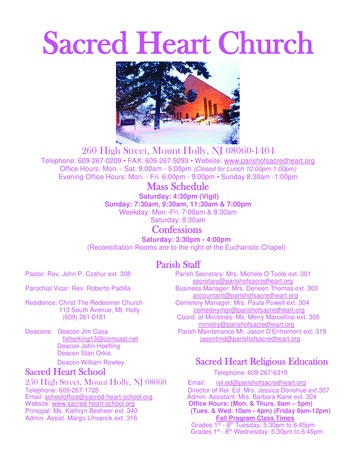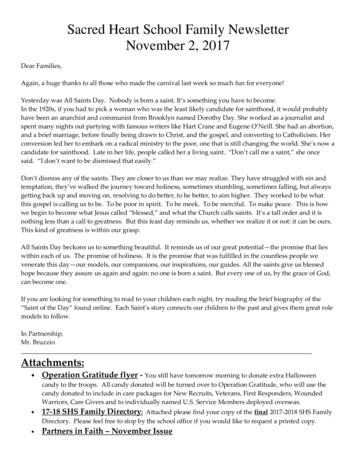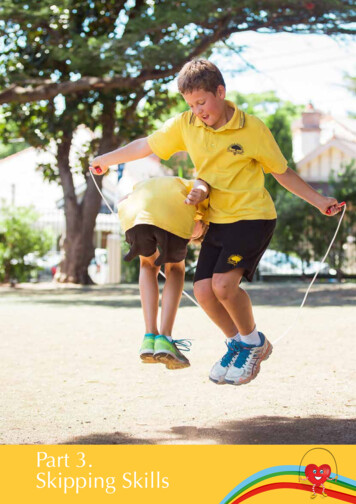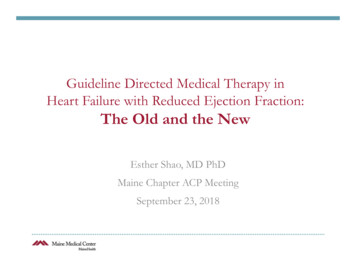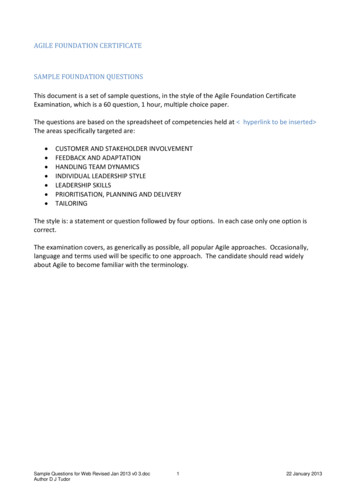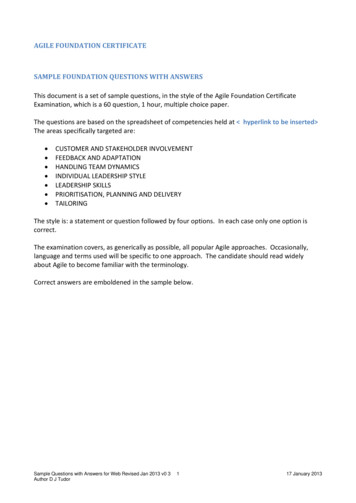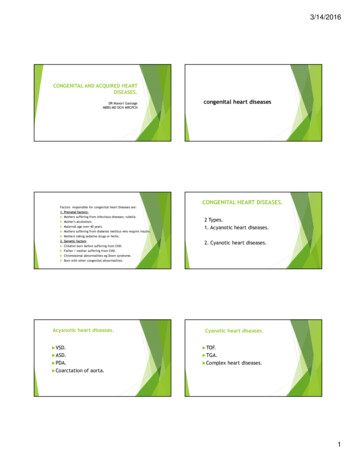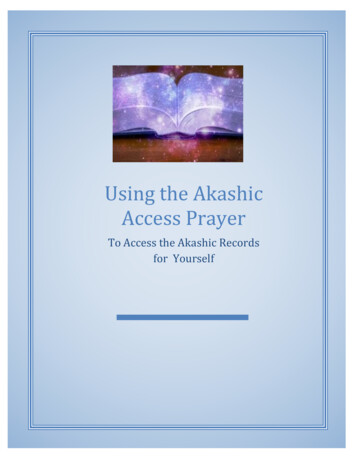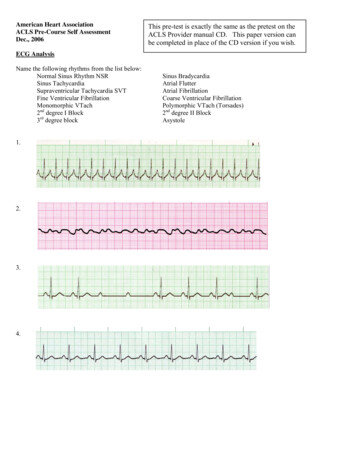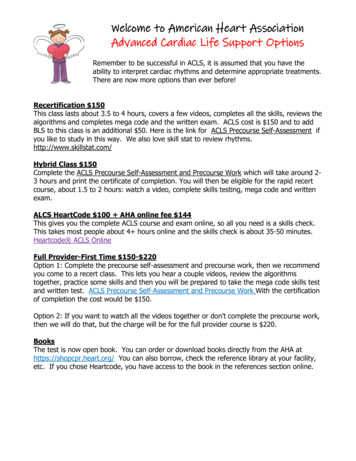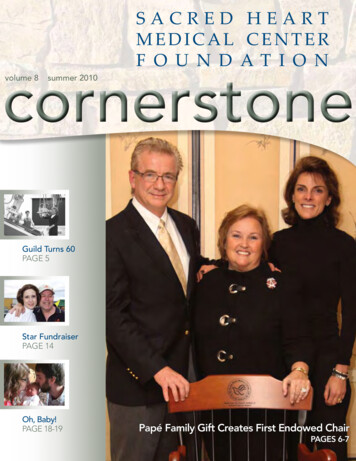
Transcription
SACRED HEARTMEDICAL CENTERF O U N D AT I O Ncornerstonevolume 8summer 2010Guild Turns 60PAGE 5Star FundraiserPAGE 14Oh, Baby!PAGE 18-19Papé Family Gift Creates First Endowed ChairPAGES 6-7
philanthropypartnersThe United States Congress has passed national health care reform. Problemsolved, right?We who care deeply about our healing ministry—donors and caregivers alike—know that the passage of the Patient Protection and Affordable Care Act is thebeginning of a journey, not the end.With or without legislation, we’ve known that how we deliver care must change—and that philanthropy will play an ever more important role.“With or withoutlegislation, we’veReform envisions a world in which hospitals and doctors are rewarded forkeeping people healthy. Shifting from a procedure-oriented, volume basedmodel to an emphasis on wellness and prevention is a change of seismicproportions. It requires providers to move beyond their silos and to collaboratetoward increased team-oriented care, integrating across disciplines to better,more cost-effectively care for patients.Right now, that’s not how most health care is practiced around the country.known that how wedeliver care mustchange—and thatphilanthropy willplay an ever moreimportant role”.PeaceHealth is working to change that. For us to deliver on the promise of reform,we must create new relationships with all the providers in our region and, together,deliver care in a more coordinated, higher quality and efficient manner.A core principle guiding this transformation is to keep patients as close to homeas possible. When it’s not possible for patients to be served at home, we mustsupport the transition to the most appropriate provider. We need to betterunderstand and communicate our role as a regional referral center and exceedexpectations in meeting the health care needs of our broader region.Because of philanthropy, Sacred Heart Medical Center is prepared to succeedin the post-reform era. As this issue of Cornerstone describes, philanthropyallows us to build programs and services—such as the development of theSurgical Institute, made possible by the generosity of the Papé family. Withoutphilanthropic support, this wouldn’t be available in our region. With it, we’re ableto offer a level of quality that surpasses anything we have previously attained.Reform creates opportunities—and challenges as well. With philanthropy,we can meet the challenge of serving more patients with the high–quality,compassionate medical care people have come to expect from Sacred Heart.ZZ2Mel PyneChief Executive OfficerPeaceHealth Oregon
insidecornerstoneJune 2010CoverZPapé Family Gift Creates the First Endowed ChairFeaturesZSacred Heart Guild Celebrates 60 YearsInstitute Development Attracts Top Brain Surgeon6-74-58Turning Research Into Reality10-11Generosity Gives Birth to New Generations18-19Sacred Heart Foundation Leadership Awards21Oregon Business Excellence Summit22DepartmentsZWorld Class Physicians9Sister Theodore Marie Society11-12Children’s Miracle Network 12-15Sacred Heart Connections16Planned Giving17Guardian Angel20Foundation Friends, Calendar22-23Sacred Heart Medical CenterFoundation Board of DirectorsJoe Gonyea III, PresidentHeidi Pollock, Vice PresidentJeff Robinson, TreasurerRon Farmer, SecretaryMike Coughlin, Immediate Past PresidentTed BakerLiz ChambersStephanie ConnorKate CoughlinBrad FenstermacherMats Fish, MDLiz GibsonAkshay Gupta, MDCharlie Hoffmeister, MDVern Katz, MDMindy LockardJeff MillerMichael Menen, MDRyan PapéA.P. ParksJack PyleMel PyneRick SkeieAugie SickLaurel SmithMike SolomonCharles WarrenPaul WeinholdMike WildishDonna WoolleyDirectors EmeritiJohn AlvordFoster AndersonBert BabbMarie BakerRuby BrockettNonnie ColeJo CourtemancheBob FenstermacherRobert FraserJo-Mae GonyeaYvonne HamsonBob HarrisonSister Monica HeeranRichard (Gus) KellerBob NewburnRalph RobinsonDonald TykesonFran WarrenCornerstone StaffExecutive Director: Rueben MayesMarketing and Communications: Karen WarnerEditor and Writer: Joanna Bartlett-GustinaDesign and Production: Deborah WeesePhotography: Deborah Weese, Joanna BartlettGustina, John Jordan Cascade, Sarah Crumley,Bruce Forster, David B. Loveall, Mandy SloanSHMC Foundation(541) 686-6958 — Telephone(541) 686-8749 — Fax(541) 501-3216 — STMS Access .org/sacredheartfoundationwww.twitter.com/SHMC Foundationwww.facebook.com/SHMCFoundation123 International WaySpringfield, OR 97477PO Box 10905Eugene, OR 97440A complete listing of donors to Sacred Heart MedicalCenter’s departments and programs is available on theFoundation website. Cornerstone is published three timesper year by Sacred Heart Medical Center Foundation.Complimentary copies are available by contacting theFoundation office. Please notify us if you do not wish toreceive materials from SHMC Foundation.3Z
Six Decades of GiftFrom the desk ofRuebenMayesSacred Heart Medical Center is growing as the hubof a large regional network of care. We need steadyphilanthropic funding to continue on this path.Why? These funds allow us to provide a margin ofexcellence. They allow us to recruit and retain worldclass physicians. In short, they can transform our clinicalareas.The Sacred Heart Hospital Guild has supportedmedical excellence at Sacred Heart for 60 years. TheGuild recently agreed to expand the endowmentfor the Oregon Cancer Institute—to provide annualfunding for oncology services in the region.This endowment enables the Cancer Institute to hiremore patient navigators and helps oncology caregiverscollaborate on treatment protocols.Another gift, the Randy Papé – Dr. David R. DeHaas, Jr.Endowed Chair for Surgery will provide critical fundingto support key surgery initiatives for our region.In the Neurosciences Institute, Andrew Kokkino,MD, was awarded an endowed directorship from theWoodard Family Foundation. It will provide at least 15,000 per year in perpetuity.These are all examples of the power of endowmentfunding to support key areas and leaders. Whether it’sendowment funding, an annual gift or a gift from anestate, philanthropy continues to make a difference inthe lives of our patients and caregivers.Rueben Mayes, MBAExecutive DirectorSacred Heart Medical Center FoundationZ4Sacred HeartIt was 1950. A group of ninewomen—mostly doctors’wives—learned that SisterMercedes needed a sewingmachine for the hospital. Sothey raised the 126 needed tobuy it by selling candy, gum andcigarettes from a telephone boothnear the hospital lobby.That’s how the Base Area #2Hospital Guild started.A Growing GuildSince then, the Guild—which nolonger sells cigarettes—has goneon to open two spacious shops,Heartfelt Gifts, at Sacred HeartMedical Center University Districtand RiverBend. And it’s helpedpurchase a lot more than a sewingmachine. In total, the Guild hasdonated more than 2.5 million toSacred Heart Medical Center fromproceeds of shop sales.Virtually every area of the hospitalhas received life-saving equipmentpurchased through the efforts ofGuild volunteers.What the Guild gives back to thehospital is more than financialsupport. “Our little corner of thehospital is a bright spot,” volunteerJan Frawley says. “It’s the placevisitors go to find gifts for patientsto brighten their stay. And it’swhere caregivers turn for a pickme-up during their shifts.”
Shop Purchases Result in 2.5 Million in DonationsHospital Guild Celebrates 60 Years of Givingthe hospital to patients andcaregivers.Top: The Hospital Auxiliary Gift Nook in 1957.Bottom: Loraine Ryan and Mildred Bartle man thegift counter.Dedicated VolunteersOver the years, membership hasgrown. From its nine foundingmembers, the Guild now has 8085 members, some of whom havevolunteered for more than 40 years.Lois Proudfit remembers thehospitality cart fondly. “We tookit to all the rooms for the patientsand nurses,” she says. “I chose todo that because I liked the patientcontact.” Lois began volunteeringwith the Guild in 1979. “I hadaspirations of joining the hospitalGuild for a long time and thought,when my kids are grown up andgone, I’m going to do that. And Idid—31 years ago.”The Guild is entirely volunteer run,its 80-plus members give at least10 hours a month—and some manymore. Jan, currently responsible forchoosing the items that the Guildstocks in Heartfelt Gifts, volunteersmore than 20 hours a week.Wilma Steinmartz joined the Guildin 1967. “I was talked into it whenI found out what my friends weredoing. It was love at first sight—and I’ve loved it ever since. Thatwas 43 years ago,” Wilma says.By 1967, the Guild’s shop hadexpanded from the telephonebooth to a small counter. ”Theshop was big enough for justcandy and gum—it was a littlecounter with an old-style cashregister. We had a lot of candy anda few gifts,” Wilma says.They also had a gift cart thatvolunteers took throughoutTop: 1986 Guild president, Sophie Luckovich,presents a Linear Accelerator that the Guilddonated 180,000 to purchase.Bottom: Rod Butler makes a purchase at theHeartfelt Gifts shop at RiverBend.Barbara Walker and Lavanda Nicol present an X-ray tablethat the Guild donated 21,875 to purchase in 1966.Why do they do it?“I think it’s an honor to be on thegiving end,” says volunteer andpast president Glenda Andersen.“The money that comes into thegift shop, it isn’t money for us; it’sgiven back to the hospital. Westarted out with a sewing machineand now we’re onto a CT scanner.The people who come into thehospital, we’re helping them. Andthe staff, we’re helping them, too.”Equipment purchasesmade possible by Guilddonations include: X-ray table Hemodialysis unit Isolettes Radio-isotope room Ultrasound machine Heart lung bypassmachines 3D image guidedsurgery equipment Bedside monitoringequipment Three labor anddelivery rooms D-SPECT nuclearscannerThe D-SPECT CTScanner at RiverBendNuclear Medicinedepartment recentlypurchased with fundsdonated by the Guild.For more information, 5Z
From left: Jordan and Keri Papé; Christian and Cheryl Papé; David R. DeHaas, MD; Lisa DeHaas; Susie Papé; Ryan and Jennifer Papé.Papé Family Gift Creates the First EnEndowment Means More Surgeons, Improved Technology, ResearchAlot can happen in 11 years.Children can find love and marry.Grandchildren can grace our lives.Without the surgical excellenceat Sacred Heart Medical Center—especially that of David DeHaasJr., MD—none of that would havebeen possible for Randy Papé. “Dr.DeHaas gave us 11 more years withRandy than we otherwise would havehad,” says Susie Papé, his widow.How do you thank a doctor orhospital for that precious gift of time?For the Papés, it was by choosingto create the first-ever endowedchair at Sacred Heart. The RandyPapé – Dr. David R. DeHaas Jr.Endowed Chair for Surgery wasannounced in March. It honors theZ6life-saving skill and compassionthat Randy received fromDr. DeHaas during hisprolonged illness. Thegoal? To allow othersto enjoy more timewith their loved ones.An Endowed Chair MakesResearch PossibleThe continuous funding that anendowed chair gives to SacredHeart allows for continuedinnovation and research. Itprovides funding for clinicalresearch—namely the staff tocollect and analyze data.“We have a great deal of case andclinical experience that we haven’tbeen able to write up, report oraudit yet,” DeHaas says. “There’s agreat potential for clinical researchby looking critically at theoutcomes of our casesover the last 10 years.”Clinical research resultsdefine surgical bestpractices and techniques.This results in better outcomesand faster recoveries for patients—at a lower cost.Addressing thePhysician ShortageThe nation is facing a significantphysician shortage—especiallyin surgery. Future physicians relyon hands-on training to gain theeducation and skills they need. Thecutting-edge skills doctors learnare then available to our patientsduring and after their training.
Giving the Gift of TimeA Letter From Susie PapéWhen Randy was diagnosedwith cancer, we knew he wasfacing a tremendous foe as hewas given four and a half monthsto live. It is no secret that we, atthat point, turned to the MayoSystem in Rochester, Minn. Theyhad the cutting-edge knowledgeand equipment to give Randy thejumpstart that he needed.dowed Chairand FacilitiesDeHaas’ plans for the endowmentinclude creating minimally-invasivefellowship and surgical residencyprograms. Combined with clinicalresearch, this allows Sacred Heartto pursue the highest level traumacenter designation—Level I. Theincrease in stature will make SacredHeart increasingly attractive to toplevel physicians.Provide SurgicalServices to Rural AreasIn addition to offering morespecialized surgical services to ourlocal patients, DeHaas believesin the importance of providingsurgical support to rural areas. Hisvision is for Sacred Heart to be thereferral center for surgical casesthat can’t be taken care of bydoctors in those areas.Not too many months afterreturning from Mayo, thecomplications began. At thatpoint, as time was of the essenceand the distance was too great,we turned to Sacred Heart andDavid DeHaas, MD, leading ateam of Gregory Knecht, MD;Dennis Gory, MD; Steven Butt,MD; Brian Robinson, MD; andLee Michels, MD. With thistalented surgical team at SacredHeart, we were able to face thisfoe head-on and, in the end, winthe fight against cancer. As hisfamily, we will always rememberRandy’s amazing strength of spiritand ineffable optimism.We soon realized, as Randysuccessfully battled throughsetbacks as a cancer survivor, thesurgical team at Sacred Heartbestowed upon our family themost precious of all gifts: Time.Because of what they did, ourfamily would have more timewith Randy than we ever thoughtpossible. Time to see three sonsmarry. Time to see grandchildrenborn. Time to travel as a family.Time to be together. Time to see abusiness flourish.Randy and RyanPapé celebratethe opening ofSacred HeartMedical Centerat RiverBend.And time enjoying the veryblessings of li
Foundation office. Please notify us if you do not wish to receive materials from SHMC Foundation. inside cornerstone Papé Family Gift Creates the First Endowed Chair Sacred Heart Guild Celebrates 60 Years Institute Development Attracts Top Brain Surgeon Turning Research Into Reality Generosity Gives Birth to New Generations Sacred Heart Foundation Leadership Awards Oregon Business Excellence .

